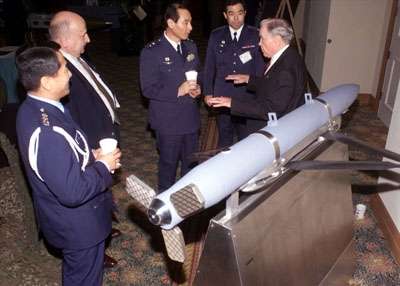Sat, Oct 08, 2005
Strange Bedfellows?
 Boeing and Lockheed Martin have
signed an exclusive teaming agreement to compete for the Small
Diameter Bomb (SDB) Increment II Program.
Boeing and Lockheed Martin have
signed an exclusive teaming agreement to compete for the Small
Diameter Bomb (SDB) Increment II Program.
Under the agreement, Boeing is the prime contractor supplying
the air vehicle and data link, and Lockheed Martin is the principal
supplier, providing the multi-mode seeker that's needed to meet the
US Air Force and US Navy requirement of hitting moving targets.
 "This agreement forms the best team
possible to provide the SDB Increment II capability," says Mark
McGraw, Boeing Weapons Enterprise Capability Center vice president.
"It combines Lockheed Martin's multi-mode seeker technology, with
Boeing's extremely successful and capable SDB system, to provide a
best-value, all-weather moving target solution and a formidable
weapon for the US military."
"This agreement forms the best team
possible to provide the SDB Increment II capability," says Mark
McGraw, Boeing Weapons Enterprise Capability Center vice president.
"It combines Lockheed Martin's multi-mode seeker technology, with
Boeing's extremely successful and capable SDB system, to provide a
best-value, all-weather moving target solution and a formidable
weapon for the US military."
As the prime contractor, Boeing will have responsibility for the
overall weapon system. Lockheed Martin has total sub-system
responsibility for the seeker system.

"Our teaming agreement with Boeing ensures the warfighter will
receive the best possible weapon system," said Randy Bigum, vice
president of Strike Weapons at Lockheed Martin Missiles and Fire
Control. "We will enhance the capability of Boeing's proven SDB I
system with the addition of our advanced multi-mode seeker. The
combination creates a new system that provides the Air Force and
Navy with a capability that has been needed for some time - the
ability to strike moving targets from standoff range."
Lockheed Martin's multi-mode seeker enables all-weather attack
and classification of moving targets, a critical requirement of SDB
II. Extensive work and testing have been done on the seeker in the
Joint Common Missile and Surveilling Miniature Attack Cruise
Missile (SMACM) programs, making it a low-risk approach. The
precision provided by the seeker will enable aircrews to attack
more targets with fewer sorties.

The US Air Force is expected to issue its formal SDB Increment
II Request for Proposal in late October. In the meantime, Boeing
and Lockheed will continue work on their proposal and continue
putting together the best team possible to win the SDB Increment II
competition. The risk reduction contract award to begin the
competition is expected next spring.
More News
Also: B-29 Superfortress Reunion, FAA Wants Controllers, Spirit Airlines Pulls Back, Gogo Galileo Van's Aircraft posted a short video recapping the goings-on around their reorganiz>[...]
Light Gun A handheld directional light signaling device which emits a brilliant narrow beam of white, green, or red light as selected by the tower controller. The color and type of>[...]
"The journey to this achievement started nearly a decade ago when a freshly commissioned Gentry, driven by a fascination with new technologies and a desire to contribute significan>[...]
"Our driven and innovative team of military and civilian Airmen delivers combat power daily, ensuring our nation is ready today and tomorrow." Source: General Duke Richardson, AFMC>[...]
Aircraft Conflict Predicted conflict, within EDST of two aircraft, or between aircraft and airspace. A Red alert is used for conflicts when the predicted minimum separation is 5 na>[...]
 Airborne 04.16.24: RV Update, Affordable Flying Expo, Diamond Lil
Airborne 04.16.24: RV Update, Affordable Flying Expo, Diamond Lil ANN's Daily Aero-Term (04.20.24): Light Gun
ANN's Daily Aero-Term (04.20.24): Light Gun Aero-News: Quote of the Day (04.20.24)
Aero-News: Quote of the Day (04.20.24) Aero-News: Quote of the Day (04.21.24)
Aero-News: Quote of the Day (04.21.24) ANN's Daily Aero-Term (04.21.24): Aircraft Conflict
ANN's Daily Aero-Term (04.21.24): Aircraft Conflict






